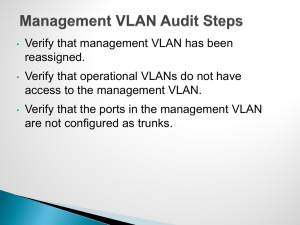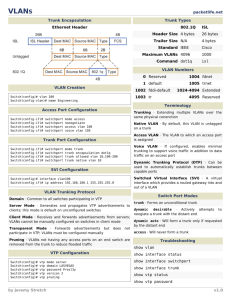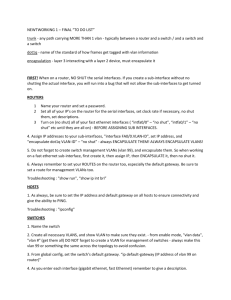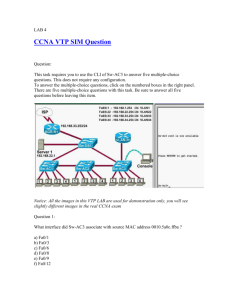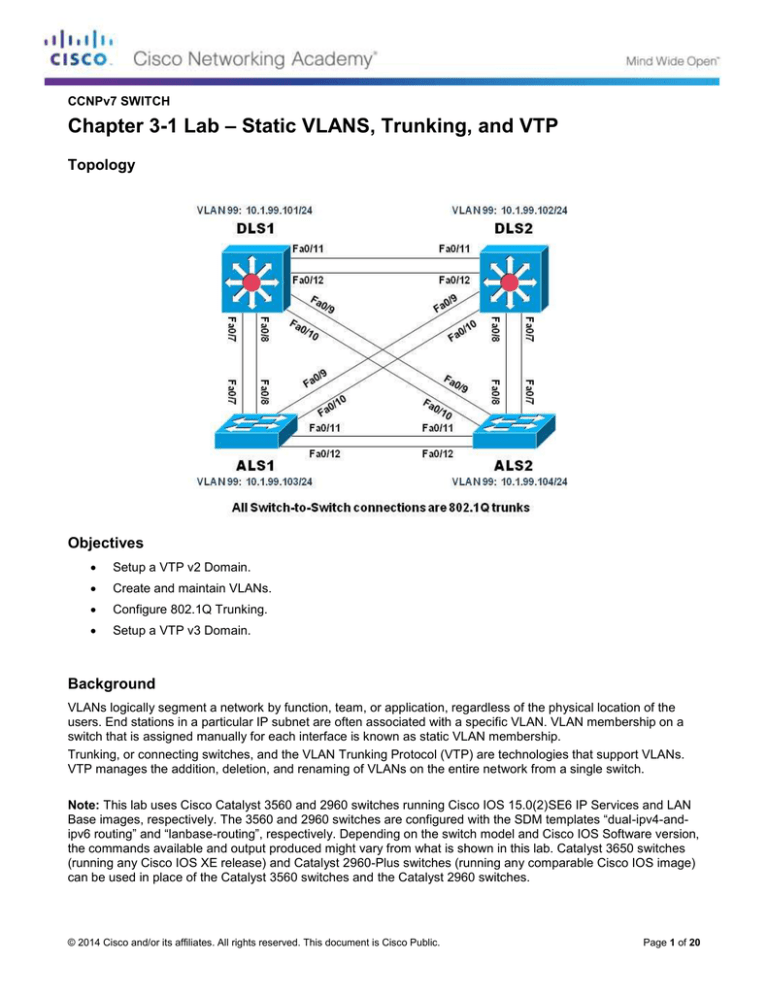
CCNPv7 SWITCH
Chapter 3-1 Lab – Static VLANS, Trunking, and VTP
Topology
Objectives
Setup a VTP v2 Domain.
Create and maintain VLANs.
Configure 802.1Q Trunking.
Setup a VTP v3 Domain.
Background
VLANs logically segment a network by function, team, or application, regardless of the physical location of the
users. End stations in a particular IP subnet are often associated with a specific VLAN. VLAN membership on a
switch that is assigned manually for each interface is known as static VLAN membership.
Trunking, or connecting switches, and the VLAN Trunking Protocol (VTP) are technologies that support VLANs.
VTP manages the addition, deletion, and renaming of VLANs on the entire network from a single switch.
Note: This lab uses Cisco Catalyst 3560 and 2960 switches running Cisco IOS 15.0(2)SE6 IP Services and LAN
Base images, respectively. The 3560 and 2960 switches are configured with the SDM templates “dual-ipv4-andipv6 routing” and “lanbase-routing”, respectively. Depending on the switch model and Cisco IOS Software version,
the commands available and output produced might vary from what is shown in this lab. Catalyst 3650 switches
(running any Cisco IOS XE release) and Catalyst 2960-Plus switches (running any comparable Cisco IOS image)
can be used in place of the Catalyst 3560 switches and the Catalyst 2960 switches.
© 2014 Cisco and/or its affiliates. All rights reserved. This document is Cisco Public.
Page 1 of 20
CCNPv7 SWITCH: Lab 3-1 – Static VLANS, Trunking, and VTP
Required Resources
2 Cisco 2960 with the Cisco IOS Release 15.0(2)SE6 C2960-LANBASEK9-M or comparable
2 Cisco 3560v2 with the Cisco IOS Release 15.0(2)SE6 C3560-IPSERVICESK9-M or comparable
Computer with terminal emulation software
Ethernet and console cables
Part 1: Prepare for the Lab
Step 1: Prepare the switches for the lab
Use the reset.tcl script you created in Lab 1 “Preparing the Switch” to set your switches up for this lab.
Then load the file BASE.CFG into the running-config with the command copy flash:BASE.CFG
running-config. An example from DLS1:
DLS1# tclsh reset.tcl
Erasing the nvram filesystem will remove all configuration files! Continue? [confirm]
[OK]
Erase of nvram: complete
Reloading the switch in 1 minute, type reload cancel to halt
Proceed with reload? [confirm]
*Mar 7 18:41:40.403: %SYS-7-NV_BLOCK_INIT: Initialized the geometry of nvram
*Mar 7 18:41:41.141: %SYS-5-RELOAD: Reload requested by console. Reload Reason:
Reload command.
<switch reloads - output omitted>
Would you like to enter the initial configuration dialog? [yes/no]: n
Switch> en
*Mar 1 00:01:30.915: %LINK-5-CHANGED: Interface Vlan1, changed state to
administratively down
Switch# copy BASE.CFG running-config
Destination filename [running-config]?
184 bytes copied in 0.310 secs (594 bytes/sec)
DLS1#
Step 2: Configure basic switch parameters.
Configure an IP address on the management VLAN according to the diagram. VLAN 1 is the default
management VLAN, but following best practice, we will use a different VLAN. In this case, VLAN 99.
Enter basic configuration commands on each switch according to the diagram.
DLS1 example:
DLS1# configure terminal
Enter configuration commands, one per line. End with CNTL/Z.
DLS1(config)# interface vlan 99
DLS1(config-if)# ip address 10.1.99.101 255.255.255.0
© 2014 Cisco and/or its affiliates. All rights reserved. This document is Cisco Public.
Page 2 of 20
CCNPv7 SWITCH: Lab 3-1 – Static VLANS, Trunking, and VTP
DLS1(config-if)# no shutdown
The interface VLAN 99 will not come up immediately, because the broadcast domain it is associated with
(VLAN 99) doesn’t exist on the switch. We will fix that in a few moments.
(Optional) On each switch, create an enable secret password and configure the VTY lines to allow remote
access from other network devices.
DLS1 example:
DLS1(config)# enable secret class
DLS1(config)# line vty 0 15
DLS1(config-line)# password cisco
DLS1(config-line)# login
Note: The passwords configured here are required for NETLAB compatibility only and are NOT
recommended for use in a live environment.
Note(2): For purely lab environment purposes, it is possible to configure the VTY lines so that they accept
any Telnet connection immediately, without asking for a password, and place the user into the privileged
EXEC mode directly. The configuration would be similar to the following example for DLS1:
DLS1(config)# enable secret class
DLS1(config)# line vty 0 15
DLS1(config-line)# no login
DLS1(config-line)# privilege level 15
Part 2: Configure VTP Version 2, VLANs, and Trunking.
A VTP domain, also called a VLAN management domain, consists of trunked switches that are under the same
administrative responsibility sharing the same VTP domain name. A switch can be in only one VTP domain, and
VLAN database contents in the domain are globally synchronized. VLAN information is not propagated until a
domain name is specified and trunks are set up between the devices.
There are three versions of VTP available; Version 1 and 2 are able to support normal-range VLANs only, while
version 3 can support normal- and extended-range VLANs, as well as the synchronization of other databases.
Support for version 3 on the Catalyst platforms used in this lab was added in IOS version 12.2(52)SE. Older IOS
versions do not generally support VTP version 3.
Switches operate in one of four VTP modes. The default VTP mode for the 2960 and 3560 switches is server
mode, however our Lab 1 configuration changes this to transparent.
VTP Mode
Description
VTP Server
You can create, modify, and delete VLANs and specify other configuration parameters,
such as VTP version and VTP pruning, for the entire VTP domain. VTP servers
advertise their VLAN configuration to other switches in the same VTP domain and
synchronize their VLAN configuration with other switches based on advertisements
received over trunk links. VTP server is the default mode.
In VTP Server mode, VLAN configurations are only stored in the flash:vlan.dat file.
While VLANs are manipulated in the configuration mode, the configuration commands
do not appear in the running-config.
VTP Client
A VTP client behaves like a VTP server and transmits and receives VTP updates on its
trunks, but you cannot create, change, or delete VLANs on a VTP client. VLANs are
© 2014 Cisco and/or its affiliates. All rights reserved. This document is Cisco Public.
Page 3 of 20
CCNPv7 SWITCH: Lab 3-1 – Static VLANS, Trunking, and VTP
configured on another switch in the domain that is in server mode.
In VTP Client mode, VLAN configurations are only stored in the flash:vlan.dat file. The
configuration of VLANs does not appear in the running-config.
VTP Transparent
VTP transparent switches do not participate in VTP. A VTP transparent switch does not
advertise its VLAN database nor synchronize its VLAN database based on received
advertisements. However, transparent switches forward received VTP messages under
two circumstances: either the VTP domain name of the transparent switch is empty (not
yet configured), or it matches the domain name in the received VTP messages.
In VTP Transparent mode, VLAN configurations are stored both in flash:vlan.dat file and
also are present in the running-config. If extended range VLANs are used, however,
they are stored in the flash:vlan.dat only if the switch is running VTP version 3.
VTP Off
A switch in VTP Off mode functions in the same manner as a VTP transparent switch,
except that it does not forward VTP advertisements on trunks. VTP off is only available
on switches that support VTP version 3 although it is not necessary to run VTP version
3 on the switch to be able to put it into the Off mode.
In VTP Off mode, VLAN configurations are stored both in flash:vlan.dat file and also are
present in the running-config. If extended range VLANs are used, however, they are
stored in the flash:vlan.dat only if the switch is running VTP version 3.
In this lab we will demonstrate the configuration and operation of both VTP versions 2 and 3. We will do this by
first configuring VTP version 2 between DLS1 and ALS1, and then configuring DLS1, DLS2 and ALS2 with VTP
version 3.
Topology
© 2014 Cisco and/or its affiliates. All rights reserved. This document is Cisco Public.
Page 4 of 20
CCNPv7 SWITCH: Lab 3-1 – Static VLANS, Trunking, and VTP
Step 1: Verify VTP status
Issue the show vtp status command on DLS1
DLS1# show vtp status
VTP Version capable
: 1 to 3
VTP version running
: 1
VTP Domain Name
:
VTP Pruning Mode
: Disabled
VTP Traps Generation
: Disabled
Device ID
: e840.406f.8b80
Configuration last modified by 0.0.0.0 at 0-0-00 00:00:00
Feature VLAN:
-------------VTP Operating Mode
Maximum VLANs supported locally
Number of existing VLANs
Configuration Revision
MD5 digest
:
:
:
:
:
Transparent
1005
5
0
0x57 0xCD 0x40 0x65 0x63 0x59 0x47 0xBD
0x56 0x9D 0x4A 0x3E 0xA5 0x69 0x35 0xBC
Because no VLAN configurations were made, all settings except the VTP mode that was changed in Lab 1
are the defaults. This switch is capable of running version 1, 2 or 3 of VTP and runs version 1 by default. All
switches in the VTP domain must run the same VTP version. The VTP mode is set to Transparent as a result
of steps performed in Lab 1. The number of existing VLANs is the five built-in VLANs. Different switches in the
Catalyst family support different numbers of local VLANs. The 3560 switch used in this lab supports a
maximum of 1,005 VLANs locally, while the 2960 switch used in this lab supports at most 255 VLANs. Lastly,
note that the configuration revision is 0.
As you should recall from CCNA, the configuration revision number is compared amongst VTPv1 or VTPv2
switches and the VLAN database from the switch with the highest revision number is adopted by all the other
switches in the VLAN management domain. Every time VLAN information is modified and saved in the VLAN
database (vlan.dat), the revision number is increased by one when the user exits from VLAN configuration
mode.
In VTPv3, revision numbers are still used but they no longer determine the switch whose database is going to
apply to the entire domain. Instead, a single designated switch in a VTP domain called the primary server is
allowed to assert its database in the entire VTP domain, even if its own revision number is lower. Other
switches that are not primary servers are not allowed to assert their databases even if their revision numbers
are higher.
Multiple switches in the VTP domain can be in VTP server mode. In VTPv1 and VTPv2, any of these server
switches can be used to manage all other switches in the VTP domain. In VTPv3, a single primary server for
a particular VTP domain is designated to control where changes originate from in the switched network. This
enables careful management and protection of the VLAN database.
Step 2: Configure VTP on DLS1.
We will start off this lab by configuring DLS1 for VTP Server mode and setting the VTP domain name and
VTP version 2. We will also set a VTP password, which provides some rudimentary protection against
© 2014 Cisco and/or its affiliates. All rights reserved. This document is Cisco Public.
Page 5 of 20
CCNPv7 SWITCH: Lab 3-1 – Static VLANS, Trunking, and VTP
automatic VLAN database propagation. Because this password is set, VTPv2 will not allow ALS1 to
automatically learn the domain name once trunks are installed.
DLS1# conf t
Enter configuration commands, one per line. End with CNTL/Z.
DLS1(config)# vtp domain SWLAB
Changing VTP domain name from NULL to SWLAB
DLS1(config)# vtp version 2
DLS1(config)# vtp mode server
Setting device to VTP Server mode for VLANS.
DLS1(config)# vtp password cisco123
Setting device VTP password to cisco123
DLS1(config)#
*Mar 1 00:29:10.895: %SW_VLAN-6-VTP_DOMAIN_NAME_CHG: VTP domain name changed to
SWLAB.
Verify these settings by using the show vtp status command again.
DLS1# show vtp status
VTP Version capable
: 1 to 3
VTP version running
: 2
VTP Domain Name
: SWLAB
VTP Pruning Mode
: Disabled
VTP Traps Generation
: Disabled
Device ID
: e840.406f.8b80
Configuration last modified by 0.0.0.0 at 0-0-00 00:00:00
Local updater ID is 0.0.0.0 (no valid interface found)
Feature VLAN:
-------------VTP Operating Mode
Maximum VLANs supported locally
Number of existing VLANs
Configuration Revision
MD5 digest
:
:
:
:
:
Server
1005
5
0
0xA7 0xE6 0xAF 0xF9 0xFE 0xA0 0x88 0x6B
0x21 0x6D 0x70 0xEE 0x04 0x6D 0x90 0xF3
Step 3: Configure VLANs on DLS1
Next configure the VLANs that will be required to support the network. As There are two ways to create
VLANs, either directly via the vlan command or by assigning an interface to a non-existent VLAN. For now,
you will create the VLANs directly on the switch. Create:
VLAN 99 to enable the management interface.
VLAN 999 as a “parking lot” VLAN for unused access ports
-
Suspend this VLAN to prevent ports in the VLAN from every communicating with each other.
The VLANs required for network operations, which are VLANs 100, 110, and 120.
Suspending a VLAN deserves a special mention. Each VLAN has an operational state associated with it: it
can be either active (the default state) or suspended. A suspended VLAN exists but it does not operate.
© 2014 Cisco and/or its affiliates. All rights reserved. This document is Cisco Public.
Page 6 of 20
CCNPv7 SWITCH: Lab 3-1 – Static VLANS, Trunking, and VTP
Access ports assigned to a suspended VLAN drop all frames and are unable to communicate, similar to ports
put into a nonexistent VLAN. Putting a suspended VLAN back into the active state reinstates normal
communication on ports in that VLAN.
To globally suspend a VLAN, use the state suspend command in the VLAN configuration mode. This state
is propagated by VTP to all other switches in the VTP domain if VTP is in use.
To locally shut down a VLAN, use the shutdown command in the VLAN configuration mode. This setting is
not propagated through VTP.
Do not confuse the shutdown command in the VLAN configuration mode with the same command available
under interface Vlan mode, which has a different and unrelated meaning. Further discussion on
suspending and reactivating VLANs can be found in Part 3, Step 7 of this lab.
DLS1(config)# vlan
DLS1(config-vlan)#
DLS1(config-vlan)#
DLS1(config-vlan)#
DLS1(config-vlan)#
DLS1(config-vlan)#
DLS1(config-vlan)#
DLS1(config-vlan)#
DLS1(config-vlan)#
DLS1(config-vlan)#
DLS1(config-vlan)#
DLS1(config-vlan)#
DLS1(config-vlan)#
DLS1(config-vlan)#
99
name MANAGEMENT
vlan 100
name SERVERS
vlan 110
name GUEST
vlan 120
name OFFICE
vlan 999
name PARKING_LOT
state suspend
vlan 666
name NATIVE_DO_NOT_USE
exit
The VLANs will not appear in the VLAN database until the exit command is issued.
After configuring the VLANs, issue the show vtp status command and you will see that the all-important
configuration revision number has increased based on these changes to the VLAN database. Note that the
revision number you have when performing this lab may be different.
DLS1#show vtp status | include Configuration Revision
Configuration Revision
: 6
Step 4: Configure trunking on DLS1
VTP will only propagate information over trunks. Cisco switches support Dynamic Trunking Protocol (DTP),
which allows automatic negotiation of trunks. The partial output here from ALS1 shows you the default
trunking mode:
ALS2#show interface f0/7 switchport
Name: Fa0/7
Switchport: Enabled
Administrative Mode: dynamic auto
Operational Mode: down
Administrative Trunking Encapsulation: dot1q
Negotiation of Trunking: On
Access Mode VLAN: 1 (default)
Trunking Native Mode VLAN: 1 (default)
© 2014 Cisco and/or its affiliates. All rights reserved. This document is Cisco Public.
Page 7 of 20
CCNPv7 SWITCH: Lab 3-1 – Static VLANS, Trunking, and VTP
Administrative Native VLAN tagging: enabled
Switches that are interconnected and have DTP enabled can form a trunk automatically if either end is in the
dynamic desirable mode or static trunk mode on the condition that either both switches use the same VTP
domain name or at least one of the switches does not yet have the VTP domain name configured.
The dynamic auto mode on both ends will prevent a trunk from automatically forming; however, this is not
really a valid safeguard against unintentional trunk connections as the port can become a trunk if the other
side changes to dynamic desirable or static trunk mode.
As a best practice you should configure each interface into either access or trunk mode and use the
switchport nonegotiate interface configuration command to disable the propagation of DTP messages.
Never leave ports to operate in the dynamic mode.
Configure the appropriate interfaces on DLS1 to be trunks.
Because DLS1 is a 3560, you must first specify the encapsulation protocol for the interface. Catalyst
3560 switches support ISL (Inter-Switch Link) and 802.1Q encapsulations for trunk interfaces. In the
topology, all the trunks are 802.1Q trunks.
Change the native VLAN from the default of VLAN 1 to VLAN 666.
Set the interfaces to be in trunking mode only, and include the switchport nonegotiate
command.
The no shutdown command is needed because the Lab 1 configuration has all interfaces
shutdown.
DLS1(config)# interface range f0/7-12
DLS1(config-if-range)# switchport trunk encapsulation dot1q
DLS1(config-if-range)# switchport trunk native vlan 666
DLS1(config-if-range)# switchport mode trunk
DLS1(config-if-range)# switchport nonegotiate
DLS1(config-if-range)# no shutdown
DLS1(config-if-range)#
By default, all VLANs are allowed on all trunks. You can explicitly control which VLANs are allowed on a trunk
by using the switchport trunk allowed vlan vlan-id command on the interface at each end of the
trunk.
There are several approaches to deciding what VLANs to allow or disallow to cross the trunk. Common
practice is to disallow VLAN 1 and the PARKING_LOT vlan. You could go a step further and disallow any
unused VLAN numbers, but you would then have to modify all the trunks should you later add a new VLAN to
the network.
In this lab, disallowing the PARKING_LOT VLAN from all trunks is not really necessary since the VLAN has
been suspended. Disallowing the VLAN can serve as an additional protection against inadvertent reactivation
of this VLAN.
Disallowing VLAN 1, also referred to as VLAN 1 Minimization, excludes VLAN 1 from the trunk but does not
restrict layer 2 management traffic (such as CDP, LLDP, VTP, STP, etc) from passing.
Since only these 2 VLANs are being disallowed, the except version of the command can be used:
DLS1(config-if-range)# switchport trunk allowed vlan ?
© 2014 Cisco and/or its affiliates. All rights reserved. This document is Cisco Public.
Page 8 of 20
CCNPv7 SWITCH: Lab 3-1 – Static VLANS, Trunking, and VTP
WORD
add
all
except
none
remove
VLAN IDs of the allowed VLANs when this port is in trunking mode
add VLANs to the current list
all VLANs
all VLANs except the following
no VLANs
remove VLANs from the current list
DLS1(config-if-range)# switchport trunk allowed vlan except 1,999
DLS1(config-if-range)#
Validate these settings by examining the switchport configuration for one of the trunk interfaces:
DLS1#show interface f0/7 switchport
Name: Fa0/7
Switchport: Enabled
Administrative Mode: trunk
Operational Mode: trunk
Administrative Trunking Encapsulation: dot1q
Operational Trunking Encapsulation: dot1q
Negotiation of Trunking: Off
Access Mode VLAN: 1 (default)
Trunking Native Mode VLAN: 666 (NATIVE_DO_NOT_USE)
Administrative Native VLAN tagging: enabled
<output omitted>
Trunking VLANs Enabled: 2-998,1000-4094
<output omitted>
Step 5: Configure VTP and trunking on ALS1
Next configure VTP and trunking on ALS1. Configure ALS1 to be in VTP Client mode and then configure all of
the appropriate trunk interfaces to use a native VLAN of 666 and to be in trunking mode only. The native
VLAN number does not have to be the same across your network, but it must match between switches on a
given connected trunk. Also, disallow VLANs 1 and 999.
ALS1(config)# vtp mode client
Setting device to VTP Client mode for VLANS.
ALS1(config)# interface range f0/7-12
ALS1(config-if-range)# switchport trunk native vlan 666
ALS1(config-if-range)# switchport mode trunk
ALS1(config-if-range)# switchport nonegotiate
ALS1(config-if-range)# switchport trunk allowed vlan except 1,999
ALS1(config-if-range)# no shutdown
ALS1(config-if-range)# exit
ALS1(config)#
After activating the interfaces, use the show interface trunk command to see the status of the trunks.
You should see interfaces Fa0/7 and Fa0/8 in trunking mode.
© 2014 Cisco and/or its affiliates. All rights reserved. This document is Cisco Public.
Page 9 of 20
CCNPv7 SWITCH: Lab 3-1 – Static VLANS, Trunking, and VTP
ALS1# show interface trunk
Port
Fa0/7
Fa0/8
Mode
on
on
Encapsulation
802.1q
802.1q
Status
trunking
trunking
Native vlan
666
666
Port
Fa0/7
Fa0/8
Vlans allowed on trunk
2-998,1000-4094
2-998,1000-4094
Port
Fa0/7
Fa0/8
Vlans allowed and active in management domain
99-100,110,120
99-100,110,120
Port
Fa0/7
Fa0/8
ALS1#
Vlans in spanning tree forwarding state and not pruned
99-100,110,120
99-100,110,120
Now if you look at the VTP status on ALS1, you will see the values are at their defaults, even though the trunk
is operational. This is because of the VTP password.
ALS1# show vtp status
VTP Version capable
: 1 to 3
VTP version running
: 1
VTP Domain Name
:
VTP Pruning Mode
: Disabled
VTP Traps Generation
: Disabled
Device ID
: 0017.95d1.8b80
Configuration last modified by 0.0.0.0 at 0-0-00 00:00:00
Feature VLAN:
-------------VTP Operating Mode
Maximum VLANs supported locally
Number of existing VLANs
Configuration Revision
MD5 digest
:
:
:
:
:
Client
255
5
0
0x57 0xCD 0x40 0x65 0x63 0x59 0x47 0xBD
0x56 0x9D 0x4A 0x3E 0xA5 0x69 0x35 0xBC
Set the VTP password on ALS1 and the VLAN database will be synchronized. However before you can set
the password, the VTP domain name must be manually configured.
ALS1# conf t
Enter configuration commands, one per line.
ALS1(config)# vtp domain SWLAB
Changing VTP domain name from NULL to SWLAB
ALS1(config)# vtp password cisco123
End with CNTL/Z.
© 2014 Cisco and/or its affiliates. All rights reserved. This document is Cisco Public.
Page 10 of 20
CCNPv7 SWITCH: Lab 3-1 – Static VLANS, Trunking, and VTP
Setting device VTP password to cisco123
ALS1(config)# end
*Mar 1 00:27:21.902: %SW_VLAN-6-VTP_DOMAIN_NAME_CHG: VTP domain name changed to
SWLAB.
Now check the VTP status and you will see a revision number matching that of DLS1, and that VLANs 99,
100, 110, 120, 666 and 999 are all in the local VLAN database.
ALS1# show vtp status
VTP Version capable
: 1 to 3
VTP version running
: 2
VTP Domain Name
: SWLAB
VTP Pruning Mode
: Disabled
VTP Traps Generation
: Disabled
Device ID
: 0017.95d1.8b80
Configuration last modified by 0.0.0.0 at 3-1-93 00:04:37
Feature VLAN:
-------------VTP Operating Mode
Maximum VLANs supported locally
Number of existing VLANs
Configuration Revision
MD5 digest
:
:
:
:
:
ALS1# show vlan brief | incl active
1
default
99
MANAGEMENT
100 SERVERS
110 GUEST
120 OFFICE
666 NATIVE_DO_NOT_USE
ALS1#
Client
255
11
6
0xF3 0x8A 0xEA 0xFA 0x9B 0x39 0x6D 0xF5
0xA6 0x03 0x2F 0xB8 0x16 0xC1 0xE6 0x8C
active
active
active
active
active
active
Fa0/1, Fa0/2, Fa0/3, Fa0/4
VLAN 999 will be missing from the filtered output above because it only includes VLANs in active state and
VLAN 999 is suspended. Using the show vlan brief without filtering would show the VLAN 999.
You will also see that the configured VLANs except VLANs 1 and 999 are allowed over the trunks
ALS1#show interface trunk
Port
Fa0/7
Fa0/8
Mode
on
on
Encapsulation
802.1q
802.1q
Port
Fa0/7
Vlans allowed on trunk
2-998,1000-4094
Status
trunking
trunking
© 2014 Cisco and/or its affiliates. All rights reserved. This document is Cisco Public.
Native vlan
666
666
Page 11 of 20
CCNPv7 SWITCH: Lab 3-1 – Static VLANS, Trunking, and VTP
Fa0/8
2-998,1000-4094
Port
Fa0/7
Fa0/8
Vlans allowed and active in management domain
99-100,110,120,666,999
99-100,110,120,666,999
Port
Fa0/7
Fa0/8
ALS1#
Vlans in spanning tree forwarding state and not pruned
99-100,110,120,666
99-100,110,120,666
You will also see that the state of interface VLAN 99 has changed to ‘up’
*Mar 1 00:27:52.336: %LINEPROTO-5-UPDOWN: Line protocol on Interface Vlan99, changed
state to up
Because ALS1 is in VTP Client mode, local changes to the VLAN database cannot be made:
ALS1(config)# vlan 199
VTP VLAN configuration not allowed when device is in CLIENT mode.
ALS1(config)#
At this point, VTP version 2 is working and secured between DLS1 and DLS2. You should now be able to
ping DLS2 from DLS1 and vice versa.
Step 6: Park unused interfaces
On DLS1 and ALS1, place all of interfaces that will not be used into the PARKING_LOT VLAN and shut them
down. For this lab, the interfaces being used on all switches are F0/7 through F0/12.
An example from DLS1:
DLS1(config)# interface range f0/1-5,f0/13-24,g0/1-2
DLS1(config-if-range)# switchport mode access
DLS1(config-if-range)# switchport nonegotiate
DLS1(config-if-range)# switchport access vlan 999
DLS1(config-if-range)# shutdown
DLS1(config-if-range)# exit
Part 3: Configure VTP version 3, VLANs, and Trunking
In this part of the lab you will configure VTP version 3 to operate across the rest of the switched network. VTP
version 3 provides some significant benefits to the network administrator.
First, the concept of a primary server was added. In VTP versions 1 and 2, all VTP server switches
are equal; any one of them may add/remove/rename VLANs and change their state. In VTP version
3, only the primary server can do this. There can be at most one primary server present in a VTP
domain. The role of a primary server is a runtime state. It is not a part of the configuration; rather, this
© 2014 Cisco and/or its affiliates. All rights reserved. This document is Cisco Public.
Page 12 of 20
CCNPv7 SWITCH: Lab 3-1 – Static VLANS, Trunking, and VTP
state is requested in privileged EXEC mode and is relinquished whenever another switch attempts to
become the primary server or when the switch is reloaded.
Second, VTP version 3 has the ability to hide the VTP password. On a VTP version 1 or 2 switch,
issuing the command show vtp password will show the password to you in plain text. VTP version
3 allows you to specify that the password be hidden in the output, preventing the password from
being inadvertently or maliciously divulged.
Third, VTP version 3 can propagate information about extended-range VLANs; VLANs numbered
between 1006 and 4094. To support these VLANs with VTP version 2, all switches had to be in
transparent mode and the VLANs had to be configured manually on a switch-by-switch basis.
Fourth, VTP version 3 only supports pruning for normal-range VLANs.
Fifth, VTP version 3 supports propagating Private VLAN information. As with extended-range VLANs,
the lack of PVLAN support in VTP version 2 required all switches to be transparent mode and manual
configuration at each switch.
Lastly, VTP version 3 added support for opaque databases. In other words, VTP version 3 can
transport more than just the VLAN database between switches. The only option at this time is to
share the Multiple Spanning Tree (MSTP) database, but room was left for expansion. We will cover
MSTP in a later lab.
VTP version 3 is backwards compatible with VTP version 2; at the boundary of the two protocols, a VTP
version 3 switch will send out both version 3 and version 2-compatible messages. Version 2 messages
received by a version 3 switch are discarded.
Step 1: Configure VTP on DLS1, DLS2, and ALS2
VTP version 3 cannot be configured unless a VTP domain name has been set, so for this step, setting the
domain name is not needed on DLS1. Configure VTP version 3 using the following parameters
VTP domain SWLAB (DLS2 and ALS2 only)
VTP version 3
VTP mode server (DLS2 and ALS2 only)
VTP password cisco123 (DLS2 and ALS2 only)
DLS1 Configuration:
DLS1(config)# vtp version 3
DLS1(config)#
*Mar 1 00:08:17.637: %SW_VLAN-6-OLD_CONFIG_FILE_READ: Old version 2 VLAN
configuration file detected and read OK. Version 3
files will be written in the future.
DLS1(config)# end
DLS1#
Example configuration on ALS2:
ALS2(config)# vtp domain SWLAB
Changing VTP domain name from NULL to SWLAB
ALS2(config)# vtp version 3
ALS2(config)# vtp mode server
© 2014 Cisco and/or its affiliates. All rights reserved. This document is Cisco Public.
Page 13 of 20
CCNPv7 SWITCH: Lab 3-1 – Static VLANS, Trunking, and VTP
Setting device to VTP Server mode for VLANS.
ALS2(config)# vtp password cisco123
Setting device VTP password to cisco123
ALS2(config)# end
*Mar 1 18:46:38.236: %SW_VLAN-6-VTP_DOMAIN_NAME_CHG: VTP domain name changed to
SWLAB.
*Mar 1 18:46:38.345: %SW_VLAN-6-OLD_CONFIG_FILE_READ: Old version 2 VLAN
configuration file detected and read OK. Version 3
files will be written in the future.
ALS2#
Step 2: Configure trunking on DLS2 and ALS2
In steps 4 and 5 of part 1, we configured and activated all the trunk interfaces on DLS1 and ALS1. Now
configure and activate all the trunk interfaces on DLS2 and ALS2.
Example from DLS2:
DLS2(config)# interface range f0/7-12
DLS2(config-if-range)# switchport trunk native vlan 666
DLS2(config-if-range)# switchport trunk encapsulation dot1q
DLS2(config-if-range)# switchport mode trunk
DLS2(config-if-range)# switchport nonegotiate
DLS2(config-if-range)# switchport trunk allowed vlan except 1,999
DLS2(config-if-range)# no shutdown
DLS2(config-if-range)# exit
DLS2(config)#
Step 3: Verify trunking and VTP on DLS2 and ALS2
Next verify that DLS2 and ALS2 trunking is operational. Here is an example from DLS2
DLS2# show interface trunk
Port
Fa0/7
Fa0/8
Fa0/9
Fa0/10
Fa0/11
Fa0/12
Mode
on
on
on
on
on
on
Encapsulation
802.1q
802.1q
802.1q
802.1q
802.1q
802.1q
Status
trunking
trunking
trunking
trunking
trunking
trunking
Port
Fa0/7
Fa0/8
Fa0/9
Fa0/10
Fa0/11
Fa0/12
Vlans allowed on trunk
2-998,1000-4094
2-998,1000-4094
2-998,1000-4094
2-998,1000-4094
2-998,1000-4094
2-998,1000-4094
Port
Fa0/7
Vlans allowed and active in management domain
none
© 2014 Cisco and/or its affiliates. All rights reserved. This document is Cisco Public.
Native vlan
666
666
666
666
666
666
Page 14 of 20
CCNPv7 SWITCH: Lab 3-1 – Static VLANS, Trunking, and VTP
Fa0/8
Fa0/9
Fa0/10
Fa0/11
Fa0/12
none
none
none
none
none
Port
Fa0/7
Fa0/8
Fa0/9
Fa0/10
Fa0/11
Fa0/12
Vlans in spanning tree forwarding state and not pruned
none
none
none
none
none
none
Next, validate VTP is operational. Here is an example from DLS2:
DLS2# show vtp status
VTP Version capable
VTP version running
VTP Domain Name
VTP Pruning Mode
VTP Traps Generation
Device ID
:
:
:
:
:
:
1 to 3
3
SWLAB
Disabled
Disabled
e840.406f.7380
Feature VLAN:
-------------VTP Operating Mode
Number of existing VLANs
Number of existing extended VLANs
Maximum VLANs supported locally
Configuration Revision
Primary ID
Primary Description
MD5 digest
:
:
:
:
:
:
:
:
Feature MST:
-------------VTP Operating Mode
: Transparent
Feature UNKNOWN:
-------------VTP Operating Mode
: Transparent
Server
5
0
1005
0
0000.0000.0000
DLS2#
© 2014 Cisco and/or its affiliates. All rights reserved. This document is Cisco Public.
Page 15 of 20
CCNPv7 SWITCH: Lab 3-1 – Static VLANS, Trunking, and VTP
Notice that the Configuration Revision number is zero and the number of local VLANs is the default of 5.
There has been no update because DLS1’s configuration revision number was reset to zero when the VTP
version was changed, so at this point DLS2 and ALS2 will not learn about the configured VLANs because as
far as they are concerned, they have the same database as DLS1.
DLS1# show vtp status | inc Configuration Revision
Configuration Revision
: 0
If we attempt to add VLANs at DLS1, or any of the other VTP version 3 switches, our attempt will not work
and we will be told that we cannot add VLANs.
DLS1(config)# vlan 111
VTP VLAN configuration not allowed when device is not the primary server for vlan
database.
DLS1(config)#
Step 4: Configure the Primary VTP Server
In a VTP version 3 domain, only the “Primary Server” can make changes to the VLAN database. Becoming
the primary server requires the vtp primary privileged EXEC command be executed. When you issue that
command, the switch checks to see if there is another switch acting as primary server already, and asks you
to confirm that you want to continue.
In the output from DLS2 above, note that the Primary ID field equals 0000.0000.0000. That field will display
the base MAC address of the primary server once a device is promoted into that role.
Also note that a separate primary server can be configured independently for each feature supported; VLAN
or MST. If no feature is specified, the vlan feature is assumed.
Lastly, there is a force option which causes the switch not to check for conflicts in the identity of the primary
server. If different switches in the VTP domain identify different switches as the primary server, there is a
good chance there are inconsistencies in the VLAN database.
DLS1# vtp primary ?
force Do not check for conflicting devices
mst
MST feature
vlan
Vlan feature
<cr>
DLS1# vtp primary vlan
This system is becoming primary server for feature vlan
No conflicting VTP3 devices found.
Do you want to continue? [confirm]
DLS1#
*Mar 1 00:22:15.634: %SW_VLAN-4-VTP_PRIMARY_SERVER_CHG: e840.406f.8b80 has become the
primary server for the VLAN VTP feature
Now verify the primary on DLS2 or ALS2:
DLS2# show vtp status | i Primary
© 2014 Cisco and/or its affiliates. All rights reserved. This document is Cisco Public.
Page 16 of 20
CCNPv7 SWITCH: Lab 3-1 – Static VLANS, Trunking, and VTP
Primary ID
Primary Description
DLS2#
: 001c.0fbf.4700
: DLS1
The promotion of DLS1 to primary increments its Configuration Revision number to 1, so the VLANs that were
previously created on DLS1 are propagated to DLS2 and ALS2 automatically.
ALS2# sho vlan brief | inc active
1
default
99
MANAGEMENT
100 SERVERS
110 GUEST
120 OFFICE
666 NATIVE_DO_NOT_USE
active
active
active
active
active
active
Fa0/1, Fa0/2, Fa0/3, Fa0/4
VLAN 999 will be missing from the filtered output above because it only includes VLANs in active state and
VLAN 999 is suspended. Using the show vlan brief without filtering would show the VLAN 999.
Step 5: Park unused interfaces.
On DLS2 and ALS2, place all of interfaces that will not be used into the PARKING_LOT VLAN and shut them
down. For this lab, the interfaces being used on all switches are F0/7 through F0/12.
An example from DLS2:
DLS2(config)# interface range f0/1-5,f0/13-24,g0/1-2
DLS2(config-if-range)# switchport mode access
DLS2(config-if-range)# switchport nonegotiate
DLS2(config-if-range)# switchport access vlan 999
DLS2(config-if-range)# shutdown
DLS2(config-if-range)# exit
Step 6: Verify VLAN management capability
DLS1 is able to create VLANs, including extended-range VLANs. Note that because ALS1 is running VTP
version 2 and its revision number is 6, it will ignore any of the VTP v2 messages sent to it because they have
a lower revision number. When a VTP message with an equal revision number but different MD5 checksum is
received, ALS1 will report an error. Here we added seven VLANs and then remove 6 of them to push the
revision number on DLS1 to 9.
DLS1# conf t
Enter configuration commands, one per line.
DLS1(config)# vlan 510
DLS1(config-vlan)# name TEST510
DLS1(config-vlan)# exit
DLS1(config)# vlan 511
DLS1(config-vlan)# name TEST511
DLS1(config-vlan)# exit
DLS1(config)# vlan 512
DLS1(config-vlan)# name TEST512
End with CNTL/Z.
© 2014 Cisco and/or its affiliates. All rights reserved. This document is Cisco Public.
Page 17 of 20
CCNPv7 SWITCH: Lab 3-1 – Static VLANS, Trunking, and VTP
DLS1(config-vlan)# exit
DLS1(config)# vlan 513
DLS1(config-vlan)# name TEST513
DLS1(config-vlan)# exit
DLS1(config)# vlan 514
DLS1(config-vlan)# name TEST514
DLS1(config-vlan)# exit
DLS1(config)# vlan 515
DLS1(config-vlan)# name TEST515
DLS1(config-vlan)# exit
DLS1(config)# vlan 1500
DLS1(config-vlan)# name TEST-EXT-1500
DLS1(config-vlan)# exit
DLS1(config)# no vlan 510-514
DLS1(config)# end
DLS1#
ALS1# show vlan brief | i active
1
default
99
MANAGEMENT
100 SERVERS
110 GUEST
120 OFFICE
515 TEST515
666 NATIVE_DO_NOT_USE
ALS1#
active
active
active
active
active
active
active
ALS2#show vlan brief | inc active
1
default
99
MANAGEMENT
100 SERVERS
110 GUEST
120 OFFICE
515 TEST515
666 NATIVE_DO_NOT_USE
1002 fddi-default
1003 trcrf-default
1004 fddinet-default
1005 trbrf-default
1500 TEST-EXT-1500
ALS2#
active
Fa0/6
active
active
active
active
active
active
act/unsup
act/unsup
act/unsup
act/unsup
active
Fa0/6
At this point, you should be able to ping each switch from every other switch.
Step 7: Change the VLAN status to deactivate ports.
As already briefly discussed in Part 2, Step 3 of this lab, the default status of VLAN 1 and user-created
VLANs is "active". A VLAN can be made locally inactive by entering the global configuration command
shutdown vlan vlan-id, where vlan-id is the number of the VLAN to be shut down.
© 2014 Cisco and/or its affiliates. All rights reserved. This document is Cisco Public.
Page 18 of 20
CCNPv7 SWITCH: Lab 3-1 – Static VLANS, Trunking, and VTP
Alternatively, the VLAN can be shutdown by issuing the shutdown command while in VLAN configuration
mode and then exiting.
Both these options are equivalent, however only the shutdown vlan command works in while in VTP
Client mode.
Shutdown the Guest VLAN 110 on ALS1, wait a few moments, exit the configuration mode and then issue the
show vlan brief command. The status should change to “act/lshut”.
ALS1(config)# shutdown vlan 110
ALS1# show vlan brief
VLAN
---1
99
100
110
515
120
666
999
Name
-------------------------------default
MANAGEMENT
SERVERS
GUEST
TEST515
OFFICE
NATIVE_DO_NOT_USE
PARKING_LOT
1002 fddi-default
1003 trcrf-default
1004 fddinet-default
1005 trbrf-default
ALS1#
Status
--------active
active
active
act/lshut
active
active
active
suspended
Ports
------------------------------Fa0/6
Fa0/1, Fa0/2, Fa0/3, Fa0/4
Fa0/5, Fa0/13, Fa0/14, Fa0/15
Fa0/16, Fa0/17, Fa0/18, Fa0/19
Fa0/20, Fa0/21, Fa0/22, Fa0/23
Fa0/24, Gi0/1, Gi0/2
act/unsup
act/unsup
act/unsup
act/unsup
Reactivate all ports in ALS1 Guest VLAN 110 using the no shutdown command in VLAN configuration
mode.
ALS1(config)# no shutdown vlan 110
As discussed and demonstrated in Part 2, Step 3 of this lab, you can put a VLAN into suspended status by
using the state suspend command while in VLAN configuration mode on a VTPv2 server switch or on the
VTPv3 primary server switch. In a mixed VTP version network, the suspension only works network-wide if it
originates from the VTPv3 primary server. Suspending a VLAN causes all ports in that VLAN throughout the
VTP domain to stop transferring data.
Suspend Guest VLAN 110 on DLS1, wait a few moments, exit VLAN configuration mode and then issue the
show vlan brief | include suspended command. The status should change show the VLAN as
suspended.
DLS1(config)# vlan 110
DLS1(config-vlan)# state ?
active
VLAN Active State
© 2014 Cisco and/or its affiliates. All rights reserved. This document is Cisco Public.
Page 19 of 20
CCNPv7 SWITCH: Lab 3-1 – Static VLANS, Trunking, and VTP
suspend
VLAN Suspended State
DLS1(config-vlan)# state suspend
DLS1(config-vlan)# exit
DLS1(config)#end
DLS1#
DLS1# sho vlan brief | include suspended
110 GUEST
suspended
999 PARKING_LOT
suspended Fa0/1, Fa0/2, Fa0/3, Fa0/4
DLS1#
Issue the show vlan brief | include suspended command on another switch in the network, and you
will see that the VLAN status is suspended as well.
DLS2# show vlan brief | include suspended
110 GUEST
suspended
999 PARKING_LOT
suspended Fa0/1, Fa0/2, Fa0/3, Fa0/4
DLS2#
Reactivate VLAN 110 using the state active command in VLAN configuration mode.
DLS1(config)# vlan 110
DLS1(config-vlan)# state active
DLS1(config-vlan)# exit
DLS1(config)#
Issue the show vlan brief | include suspended command on another switch in the network, and you
will see that the VLAN status is no longer listed.
DLS2# show vlan brief | include suspended
999 PARKING_LOT
suspended Fa0/1, Fa0/2, Fa0/3, Fa0/4
DLS2#
Step 8: End of Lab
Save your configurations. The equipment should be in the correct end state from this lab for Lab 3-2,
EtherChannel.
© 2014 Cisco and/or its affiliates. All rights reserved. This document is Cisco Public.
Page 20 of 20



